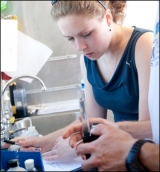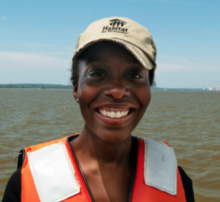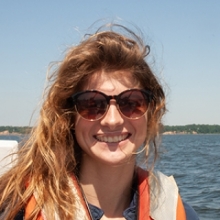Eight students will be presenting the summer work at the Ocean Sciences Meeting in March 2022!
Emily Donaldson, Wilmington College
Class Year:
2010Mentor:
Andy Lazur, Ph.D.Project Title:
Evaluation of the Physiological Effects of Sublethal Nitrite Exposure in Juvenile Atlantic Sturgeon (Acipenser oxyrinchus oxyrinchus)
Abstract:
Nitrite can accumulate in the water in natural and hatchery settings and elevated levels are toxic to many fish. This study evaluated effects of 1 mg/L nitrite on methemoglobin, PCV (packed cell volume), hemoglobin and plasma chemistry in Atlantic sturgeon (Acipenser oxyrinchus oxyrinchus). Juvenile fish (0.544 kg ± 0.126 SD) were divided into two treatment groups of chloride concentrations of 0 mg/L and 50 mg/L. The percent methemoglobin in the 0 mg/L chloride group was 81.936 (68.182, 87.719), median (1st quartile, 3rd quartile), at 96-hours post exposure and was significantly different from the 50 mg/L chloride group which had a percent methemoglobin of 7.895 (4.762, 10.811) (P < 0.05). Two weeks after removal from nitrite, elevated methemoglobin was observed in the 0 mg/L chloride group with a percent of 71.429 (62.963, 90.476). PCV decreased significantly in both groups (P < 0.05). The 0 mg/L treatment group dropped in percent PCV from 30 (29, 32) to 7 (5, 9) and the 50 mg/L treatment group dropped in percent from 29.5 (28, 32) to 15 (13, 18) over the duration of the study. Total hemoglobin decreased significantly from 6.6 g/dL (6.2, 6.8) to 5.6 g/dL (5, 7.1) in the 0 mg/L chloride group and from 6.2 g/dL (5.9, 6.6) to 4.3 g/dL (3.5, 5.3) in the 50 mg/L chloride group (P < 0.05). Nitrite resulted in severe hemolytic anemia and mortality of 60% in the 0 mg/L chloride group and was less severe with no mortality in the 50 mg/L chloride group. Nitrite accumulation at a chloride level close to 0 mg/L is toxic and multiple stressors can result in significant mortality.
Publications:
Matsche, M.A., E. Markin, E. Donaldson*, A. Hengst, and A. Lazur. 2012. Effect of chloride on nitrite-induced methaemoglobinemia in Atlantic sturgeon, Acipenser oxyrinchus oxyrinchus (Mitchill) . Journal of Fish Diseases 35:873-885 .







































